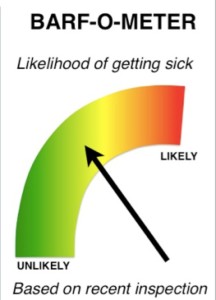My philosophy on disclosing restaurant inspection information hasn’t wavered much in the past 10 years: Make inspection results public and communicate them meaningfully to help patrons make decisions. There’s a patchwork approach to disclosure throughout the world: happy faces, letter grades, number grades or the not-well-used barf-o-meter.

Whatever the system is, it’s necessary to pull back the curtain on what happens when inspectors are around. The transparency not only builds trust in the system, but also allows folks to choose businesses based on their own risk tolerance.
According to Australia’s Fraser Coast Chronicle, businesses will be provided with a rating score but will not be required to post it. The hope is that businesses receiving a stellar score will see the marketing advantage and will voluntarily post the ratings – while those not posting due to less-than-ideal ratings will raise their level of attention to get the higher rating.
Businesses will not be forced to display their ratings but the thinking is those with better scores will display to gain customer trust and improved trade.
A report showed those with a lower rating would be made to pay more fees, while the businesses that scored better paid less because fewer inspections were needed.
Joep Dekker from Wild Lotus in Hervey Bay said he would proudly display his score.
He said he was confident of a strong rating because he knew his business had high standards when it came to cleanliness.
“It is something to be proud of, a good score,” he said.
According to the Journal Gazette, Fort Wayne-Allen County (Indiana) health department is taking a different path to disclosing inspections: Moving to a risk-based rating and a corresponding smartphone ap.
Ann Applegate, director of the health department’s Food and Consumer Protection Division, said her department is considering programs from across the country to find a good match for the county.
“We have been looking at several different models of these restaurant grading systems and seeing how we can implement those into what we currently have,” Applegate said.
The new grading scale or points system would place more emphasis on risk-based violations, making it easier for the public to understand the severity of the violation.
[Mindy] Waldron said the department is also in the process of developing an app for smartphones that would allow people to view public documents such as food and beverage inspections.
